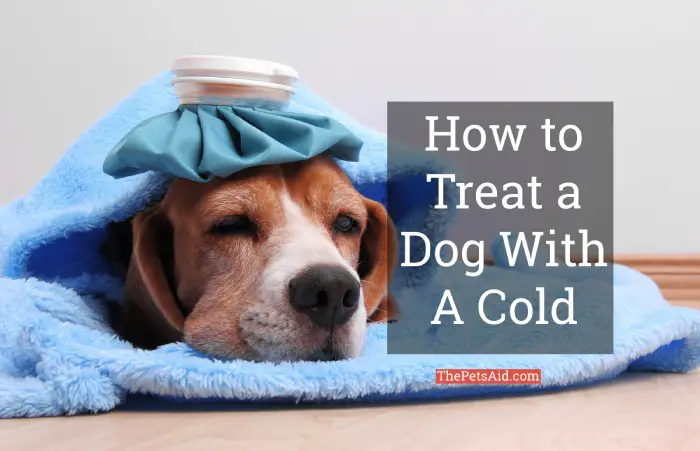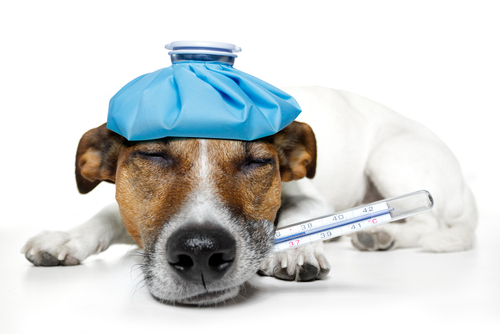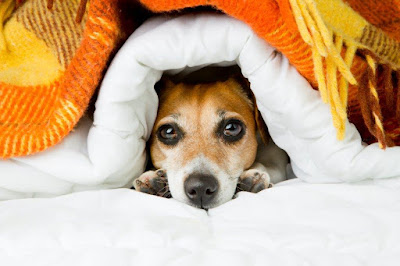learn how to treat a dog with a cold: Just like people, animals can also get cold, especially in winter. Here we are going to give you some guidelines that can help you prevent a cold in dogs.
How to Treat a Dog With a Cold
Winter is coming, and with it comes Christmas, snow, cold and, of course, colds. Almost as typical as hats or scarves are handkerchiefs and warm glasses of honey milk as methods of combating annoying symptoms. And unfortunately, pets don’t get rid of a cold when cold temperatures hit. For this reason, below, we will discuss several useful tips on How to Treat a Dog With a Cold.

Protect your pet from the cold! And it is that animals, like people, can catch a good cold. The symptoms of a canine cold are similar to ours. In essence, general malaise, headache and muscle pain, acute cough, and frequent sneezing with mucus, loss of appetite, inactivity, and lethargy. In cases of a strong cold, it may even present fever. It is important to prevent and take good care of the cold dog to avoid a badly cured a cold from leading to other respiratory diseases.
What is Cold?

The cold is a complex of diseases that affect the respiratory system of dogs. Viruses such as CAV-1 and CAV-2, of the Adenoviridae family, canine parainfluenza virus, herpesvirus, and bacteria such as Bordetella bronchiseptica or Streptococcus are involved. Other pathogens may be involved since when one of them starts the infection. The others often join the party. But those we have cited are the most common and the ones that produce the most symptoms.
And What Are the Symptoms of the Cold?
When affecting the respiratory system, the most common symptoms are related to it. However, it can also affect other organs such as the eyes. The most frequent symptoms are the following:
- Cough more or less frequent, and of variable intensity. In the veterinary clinic environment, it is the so-called ” goose squawk” because of its obvious similarity. The cough can be dry or wet, that is, with associated mucus. Situations like exercise or nervousness can exacerbate this symptom. This cough will always be involved in the cold. That is, if the dog does not cough, it cannot have a cold, making it the most important and characteristic symptom. The following symptoms do not always appear in a cold dog.
- Fever, mild to moderate, or moderate-high. The animal may have fluctuating hyperthermia. It usually never usually reaches 40ºC.
- A runny nose, depending on the degree of the condition, can be clear and fluid or more dense and colored.
- Apathy and lethargy, especially when a fever is present.
- Secretion eye.
- Dyspnea, more marked in intense exercise.
Is It a Disease That Poses a Serious Risk to the Health of My Dog?
Generally speaking, no. As in people, it is usually a self-limiting process, which, as it comes goes, without further complication. However, there are populations at risk, such as very young puppies, elderly dogs, with a compromised immune system, or with some other concomitant disease that may aggravate the clinical picture of the cold. In these animals, the treatment must be more careful and exhaustive.

Treatment consists of administering antibiotic medications to control bacterial infections. Symptomatic relief is also useful, through the administration of antitussives or nebulizations to hydrate the respiratory mucosa.
Tips to Prevent Cold in Dogs
To prevent a cold in dogs, it is best to consider the following:

- Respect the vaccination schedule: the measure par excellence to prevent the cold in dogs. The vaccines included in the vaccination plan have attenuated strains for the main cold-causing pathogens, so it is advisable always to follow veterinary advice and vaccinate dogs with the indicated guideline.
- Vaccine for parainfluenza: special mention requires the vaccine against the parainfluenza virus, one of the viruses involved. For this virus, if there is a vaccine, only it is not present in the usual vaccination schedule, so dogs are usually recommended to be in communities (residences, hotels), where the risk of infection is higher. It is frequent that this vaccine is an indispensable condition in many of these places.
- Protect dogs from the cold: especially if they are short-haired or small breeds. They should go outside with warm clothes to mitigate the effects of low temperatures. If also, the coat is waterproof and we protect you from the rain if it rains, better than better.
- Avoid having very high heating at home: we have to take into account that the hair of dogs protects them, so they have an eternal coat. It is advisable, without us freezing, to moderate the temperature inside the home and thus avoid the sudden change in temperature when going outside.
- Keep your throat moist: especially if we are going to take a long walk. It is advisable to bring a little water to give him to drink from time to time since with a dry throat. It is easier for pathogens to proliferate in it.
- Avoid thermal shocks. Sudden changes in temperature are the leading cause of colds. Avoid strong temperature contrasts and air currents, especially in cold months. The months of heat avoid contrast with air conditioning.
- Protection on the street. If it’s cold or rainy, putting on dog clothes like a sweater or raincoat will help protect you.
- Avoid humidity. After bathing and when you return from the street on cold and rainy days, dry it well with the towel and blow dryer with warm air to remove moisture from the hair.
- Centers with other dogs. If the dog is going to be a few days in a residence or a canine center with other dogs, the cough vaccine for the kennels can be administered to avoid the spread of the virus.
What to Do If My Pet Has Cooled Down?

- Avoid cold and reduce activity. If the dog has cooled down, try to take short walks when it is less rainy and cold. You may also feel sluggish, reduce activity, and exercise.
- Take care of your rest. At home, it is important to take care of your rest, so you must provide a calm and warm environment (without drafts) so that you can sleep and recover, without disturbing you.
- Good hydration. It is very important to keep it well hydrated and to have fresh water always available if you notice that it does not drink water, you can try to give it directly with the help of a syringe for syrups or by giving it moist feed. Which contains more water content than dry feed or adding a little warm water to your usual dry feed.
- Encourage appetite. With cold and discomfort, the dog may lose its appetite. To replenish fluids and energy, you can motivate him by preparing a homemade chicken or boiled rice broth (without onion).
A cold or canine cold usually subsides over the days. If you notice that it does not improve, see your vet for a review and rule out other health problems. We hope you find these tips helpful and put them into practice to reduce the likelihood of annoying colds.
